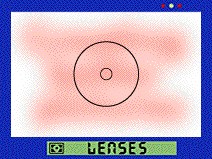
By the Photo-Tech Center, Nikon Corporation
![]()

By the Photo-Tech Center, Nikon Corporation
| Different Types of Lenses |
|---|
| There are various types of lenses, including wide angle, standard, telephoto, zoom,
micro (or macro), useful for shooting closeups of flowers, fisheye, offering picture angle
greater than 180 degrees for a distorting effect, and short-length telephoto (or reflex)
lenses. The Nikkor lineup features lenses for every conceivable purpose. Let's look into the characteristics of each type of lenses. |
| Wideangle lens | ||
| A wide picture angle lets photographers capture on film more of what's in front of them. Also, increasing aperture value (or "stopping down") effectively deepens the depth of field, and emphasizes the subject in relation to surroundings. Try not to position the camera bottom parallel to the ground. Down shot (pointing lens downward) and tilting makes for more dramatic shots. | 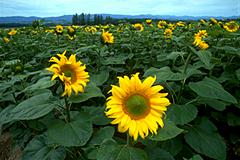 Photo taken with wideangle lens |
|
 |
Note Come close to the main subject and take a picture by increasing the aperture value. |
|
| Standard lens | |
| The picture angle of a standard lens most closely approximates a human
eye's view, offering a natural perspective with hardly any distortion or emphasis. Increase aperture value ("stop down") and make a down shot to create a wideangle lens effect. Decrease aperture value ("open up"), to enlarge out-of-focus area and create a telephoto lens effect. Since the f-number (maximum aperture) is small (lens is bright), a standard lens can use a high shutter speed even in dark places. |
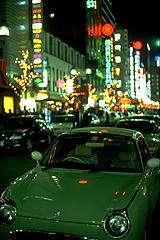 Photo taken using a standard lens |
| Telephoto lens | ||
| These are great for capturing closeup views of faraway scenes, emphasizing the subject while blurring the foreground and background by effectively compressing perspective and making depth of field shallow. | 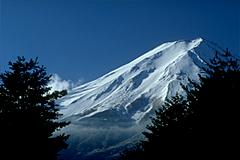 Photo taken using a telephoto lens |
|
 |
Note Decreasing aperture value (opening up) helps to emphasize a main subject. |
|
| Zoom lens | |
| A zoom lens expands compositional capability allowing free adjustment of focal length. If the range of zooming is from wideangle to telephoto, it is versatile for trips and occasions when you don't want to carry more than one lens. Usually, the f-number of the zoom lens is large (lens is dark), so the shutter speed becomes slow. Therefore, it is good to use a tripod and beware of camera shake with a zoom. | 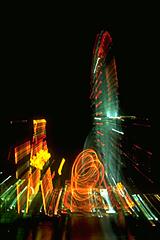 Photo taken using a zoom lens |
| Micro lens (also known as Macro lens) | |
| With a standard lens or a telephoto lens, you can get as close as about 45cm ~ 1m from the subject - not close enough for a closeup of a small flower. Micro lenses are very good for frame-filling closeups as well as general shooting, making them very efficient for use in all types of situations. Nikon also has a Zoom-Micro lens. |  Photo taken using a micro lens |
| Fisheye lens |
|
| This offers a picture angle equal to or greater than 180 degrees - a field of view beyond the capability of a human eye. That's what "fisheye" refers to: a fish's-eye view as it looks up from under water. When using such a lens, tilting the camera slightly creates a highly distorted image. |  Photo taken using a fisheye lens |
| Reflex lens |
|
| Known as a reflex-telephoto lens, this lens allows light to pass through the front, reflect off a back mirror, reflect off a front mirror, and finally reach the film surface. This lens creates blurred O-shaped rings from light reflecting off water in the background. The lens is short and light, but at maximum aperture the lens is darker than a standard lens. | 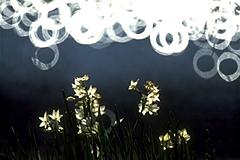 Photo taken using a reflex lens |
| With this issue, we conclude our discussion of camera and lens basics. Starting next
issue, we'll tell you basic information about speedlights, close-ups, filters, etc. Now that we have devoted 9 issues to aspects of taking good pictures, let's review some of the essentials: |
| 1) Preventing camera shake |
| Use your right hand and grasp the camera's handgrip firmly. Support the camera in the palm of your left hand with your elbow poised against your body for additional support. |
| 2) Using focus lock |
| Most AF cameras have focus brackets at the center of the viewfinder. This is fine for shooting a person in center frame. But when taking a picture of two people side by side, neither of whom is positioned within the focusing brackets, and thus the camera will focus on the background, and the people will be blurred unless focus lock is used. |
| 3) Taking special pictures |
| When taking a special picture with beautiful scenery and a unique building in the background, first decide on the composition. Then, ask your model to come closer to the camera, so that he or she dominates the picture. |
| 4) Adding variety to composition | |
| Use focus lock to frame the main subject out of center frame whenever possible. If you have trouble deciding on photographic composition, try situating your subject onto a dividing line and any of their four intersections (see right). |  Partitions of three |
| 5) Using speedlight | ||||||||||||||
| When taking an indoor shot of a person in front of window leading outdoors, or when taking a person in a backlit situation, the person will appear dark in the final shot if you shoot without a speedlight. Use a speedlight under such conditions, and the person, as well as the scenery outside the window, will be well-illuminated. | ||||||||||||||
| 6) Compare vertical and horizontal composition | ||||||||||||||
| Whether a picture is framed using vertical or horizontal orientation
greatly influences the total inspirational effect. Verticals emphasize height and are good
for framing a whole person from head to toe. Horizontals emphasize width and are good for
flat landscapes. Compare for yourself. Vertical composition accents "height" Horizontal composition accents "width" |
||||||||||||||
| 7) Exposure compensation | ||||||||||||||
| When shooting a landscape, the picture appears dark due to under-exposure when the sky takes up most of the image. In such cases, you should provide plus (+) compensation. But when filling a shot with a black locomotive or other subject with dark background, the picture appears too light due to over-exposure. In such cases, you should provide minus (-) compensation. | ||||||||||||||
| 8) Exposure bracketing | ||||||||||||||
| It's most difficult to set exposure when shooting in the delicate light of dusk and dawn. In such cases, use the camera exposure meter as a guide and take pictures using both plus and minus compensation. After you see the results, choose the effect that you prefer and remember the settings you used to achieve it. | ||||||||||||||
| 9) Different types of lenses | ||||||||||||||
|